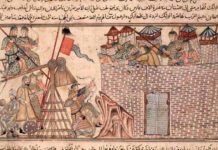The Saffron Revolution in Burma has witnessed thousands of Buddhist monks leading the demonstrations against the vicious, repressive military regime that misrules the country. Many of the monks have headed to the Shwe Dagon Pagoda in the previous capital of Rangoon (also known as Yangon) and have paraded around this pagoda.
It is clearly of great religious and national significance, not to mention the obvious architectural splendour of the building itself. So what is the pagoda and what is it for?
In Buddhist thought, a pagoda is a structure within a temple complex which serves as a repository for relics and other holy items. Pagodas were originally derived from India, where they are known as stupas and it is by this name that they are still mostly known in Southeast Asian Buddhism, since it uses the pali language which is so similar to the ancient Sanskrit language which was the medium for bringing Buddhism from India to East Asia.
Western people usually call the stupas ‘pagodas’ because of coming across them first in China. In Burma, pagodas generally take the form of a pyramidal tower of several storeys, depending on the availability of resources and the importance of the relics housed. The Shwe Dagon Pagoda is the largest and most significant in Rangoon and it is covered in gold leaf, to reinforce the importance of its heritage. It is 99 metres high (326 feet) and is built on a hill about a mile north of the cantonment – the British part of the colonial city – which is itself some 51 metres or 168 feet in the air.
The Shwe Dagon Pagoda is at least six hundred years old, since it was in the fifteenth century that the area around the pagoda, which had come to be known as Dagon in honour of the building, that the Mon kings who then dominated the region of Lower Burma raised it to the status of a town. In the 1750s, the Burman King Alaungpaya conquered the Mon kingdoms and renamed Dagon as Rangoon, the ‘end of strife,’ while making it a capital for the country.
Burmese kings have regularly changed the location of their capitals throughout the years. Since then, the Shwe Dago Pagoda has presided over a city which grew, for a while, into a tidy and impressive centre of rice trading, government and business. Decades of misrule since independence, most particularly since the coup which put the junta in power, have made Rangoon a much shabbier, poorer and smellier place. The Pagoda, however, still stands as a memory of better days.







